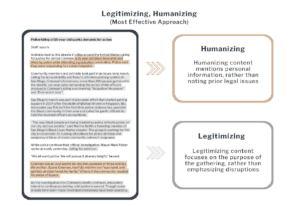
Protest coverage can often be harmful to underrepresented groups – casting both the protesters and their causes in a negative light. To help journalists frame stories in ways that do not marginalize these groups, the Center for Media Engagement tested several approaches to protest coverage.
The results showed that stories that humanize – rather than criminalize – the person whose death sparked a protest can lead people to have more positive attitudes toward the person, the protest itself, and the protesters. Additionally, stories that legitimize the protest itself can result in more positive attitudes toward the protest and the protesters.
Study Findings
Set-up
The study focused on two story areas that are often problematic when covering protests – whether the person whose death spurred the protest was humanized or criminalized and whether the protest itself was legitimized or delegitimized.
Participants in the study viewed a news story about a protest that stemmed either from the death of a Black teenager shot by police or from the death of a Latin American immigrant teenager who died in a migrant detention center. These two topics were chosen because, historically, protests challenging racism and colonialization have received the type of coverage that marginalizes or delegitimizes protesters and their causes.
The story either legitimized or delegitimized the protest and either humanized or criminalized the teenager whose death spurred the protest. Multiple parts of the story were changed to reflect the different types of stories for each topic.
Results
Stories that humanized the teenager whose death sparked the protest led people to have more positive attitudes toward the teenager, the protest itself, and the protesters. Humanizing stories also led Democrats and those with Democrat-leaning views to perceive the news story as more credible. Republicans and those with Republican-leaning views perceived the humanizing story as less credible.
Stories that legitimized the protest resulted in more positive attitudes toward the protest and the protesters. Legitimizing stories had no effect on attitudes toward the teenager in the story or on perceptions of the story’s credibility.
What Newsrooms Can Do
Humanize the Story
Reporters can share personal information about the person who is the focus of the protest to help humanize a story. These details can include writing about the person’s personality, hobbies, and family to give a fuller picture of their life. Sharing information about the circumstances that led to the protest can also give some much needed context to the story. These details, rather than information about the person’s criminal past or speculation about possible criminal activity, should be the focus of the story.
Legitimize the Story
Instead of emphasizing disruptions, stories should focus on the purpose of the demonstration. Reporters can include motivations for the protest, the changes that protesters are calling for, and background information on the broader movement and relevant past events. If the actions of protesters are covered, peaceful and non-radical demonstrations should be acknowledged, especially if damages and violence resulting from the protest are being discussed.
Takeaways
Protest stories, especially those that involve underrepresented groups, should focus on the purpose of the demonstration and share details that help humanize the person at the center of the protest. This approach may help people better understand the reason for the protest as well as give a more complete picture of the person at the center of the protest.
In some cases, taking a humanizing approach can also boost perceptions that the news story is credible. While this may backfire with some audiences, the benefits of telling stories in humanizing and legitimizing ways outweigh the drawbacks.
The full report is available on the Center for Media Engagement website. Journalists interested in reading more about bridging divides can also visit our page dedicated to journalist resources on this issue.



